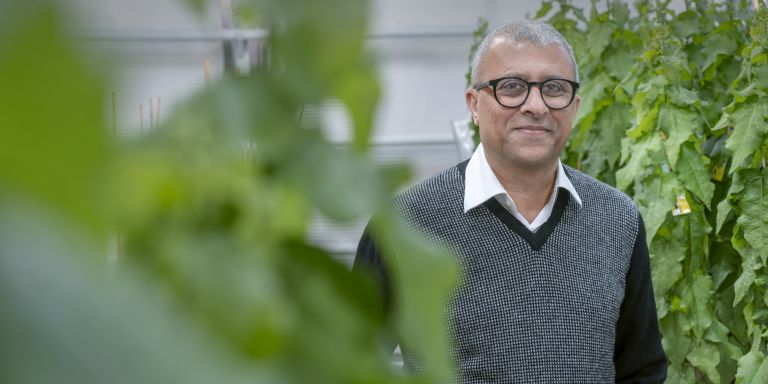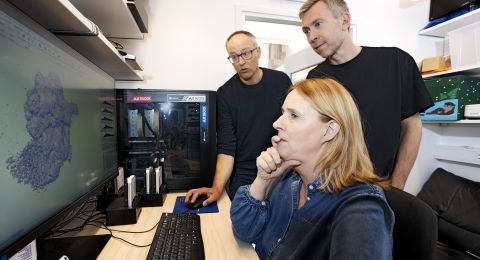Rishikesh Bhalerao’s specialty straddles one of the most exciting crossroads in the research world. He aims to solve one of nature’s great mysteries: how do plants, without a brain or a nervous system, interpret and respond to the noisy world around them?
Rishikesh Bhalerao
Professor of Plant Cell and Molecular Biology
Wallenberg Scholar
Institution:
Swedish University of Agricultural Sciences
Research field:
How plants adapt their growth to their environment, with the emphasis on molecular processes
In a world of rapid climate change, our forests are facing major challenges. How can trees, which have successfully adapted to thousands of years of stable seasonal variations, cope with a future with less predictable temperature variations? Bhalerao, who is Professor of Plant Cell and Molecular Biology at the Swedish University of Agricultural Sciences, has spent his career researching precisely this question. His findings have the potential not only to deepen our understanding of nature’s finely tuned mechanisms, which enable trees to adapt to seasonal changes, but also to help us to conserve forest ecosystems.
Bhalerao’s research focuses on the annual growth cycle of trees. Trees in boreal or temperature regions stop growing and form buds before winter, and then remain dormant until spring, when the buds start to grow again. The timing of spring bud growth is crucial to the trees’ survival. It is therefore obvious that the buds make a critical choice when they decide to start growing. But how does a bud know when it is time to come to life?
“Plants live in a ‘noisy’ environment, in which signals like temperature vary constantly. Yet they manage to make robust decisions that determine their survival,” he says.
Bhalerao’s research shows that temperature sensing by trees is complex. Rather than detecting average temperatures, they can also interpret variations, such as sudden cold spells or heat waves. This ability is crucial to the tree’s survival – their buds must end their dormancy and start growth at the right time, so they are not harmed by late frosts.
“Premature bud-break may cause plant tissues to die from sudden freeze events, whereas a delayed process shortens the growing season, adversely impacting forest health and productivity,” says Bhalerao.
Molecular secrets behind a bud
His team has discovered that cell–cell communication in buds plays a key role in the process. In winter, communication between bud cells is blocked by a polysaccharide called callose. If the buds are to reawaken, this obstacle must be removed. This is controlled by a complex genetic network.
“It’s fascinating to see how trees use molecular mechanisms to interpret long and short periods of cold. They sense the progress of winter and prepare for the advent of spring,” says Bhalerao.
The Wallenberg Foundation grant enables the research team to study these processes in even greater detail. Among other things, they are conducting experiments that simulate natural temperature variations.
Impaired growth cycle
Bhalerao believes his research is creating ample potential to gain an understanding of how climate changes impact plants in general, and trees in particular. Warmer and less predictable winters may impair the growth cycle of trees, jeopardizing ecosystems and forestry alike.
“Trees are impacted not only by average temperatures, but also by fluctuations. Our studies show that rapid fluctuations in temperature, which are expected to become increasingly common, may compromise the ability of buds to interpret seasonal transitions. This could have disastrous implications for our forests. We can already see how insufficient cooling or sudden temperature fluctuations adversely impact trees. If we can understand the mechanisms underlying these effects, we will be able to help mitigate climate impact,” he says.
The ability of buds to interpret sudden cold spells or heat waves is crucial for the tree’s survival – their buds must end their dormancy and start growth at the right time.
The motivation behind this advanced research is simple – curiosity.
“It’s a fundamental human need to understand the world around us. For me, it’s about revealing how plants, without a brain or nervous system, manage to make such precise decisions. It’s one of nature’s great mysteries,” says Bhalerao.
Forests and research of the future
Thanks to the funding they have received, Bhalerao’s team can now recruit more postdocs, and also perform experiments by exposing trees to fluctuating conditions that more closely resemble the natural environments to which the trees are exposed. The team can also use advanced techniques, such as electron microscopy and climate modeling, to delve even deeper into the secrets of trees. Ultimately, Bhalerao hopes their work will not only yield insights into the adaptive abilities of plants, but also practical solutions to secure the future of our forests.
“Forestry is of central importance to Sweden, and we hope our research will help to assure productivity in a changing climate. We now have a unique opportunity to take our research to the next level. We will be able to carry out long-term research in which we can take risks and explore questions that have not been answered – and that cannot be answered simply with the help of short-term research,” he says.
He hopes his research into trees will create insights that help both researchers and the forest industry to meet the challenges of the future.
“In a time of rapid climate change we need all the knowledge we can get to ensure that our forests – one of the most important resources on the planet – can survive and thrive.”
Text Elin Olsson
Translation Maxwell Arding
Photo Johan Gunséus






